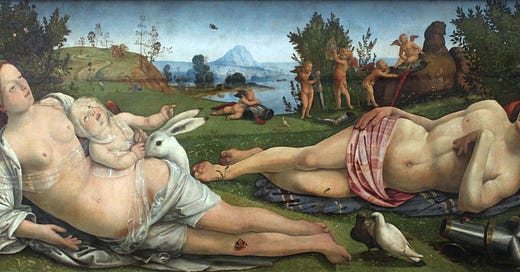Dear friends of Daily Philosophy,
If you are into binary numbers, you’ll have noticed today’s round number. We have reached 11111111 (0xff) posts in this newsletter! From now on, we’ll need two bytes to keep track of these articles.
I won’t bore you with the usual excuse for why this newsletter is late once more (it’s the same reason it has been for weeks: too much work). Instead, we can just be happy about the upcoming holidays that will give all of us a pause to breathe — and perhaps get those things done that we have been putting off for too long. In my case, that’s a new episode of the Accented Philosophy Podcast, where Ezechiel Thibaud and I talk about Effective Altruism. It’s now in the edit, and hopefully next week you’ll be able to find it in your podcast player.
So now let’s jump into today’s topic. Given the onslaught of chocolate eggs and bunnies, it can be nothing else than an attempt to make sense of rabbits’ trans-avian reproductive habits.
Easter eggs
An “Easter egg” in software is a “secret” function hidden in a computer program. Often it’s something funny that users are expected to find and enjoy: a joke, a surprising little game, or a message from the developers.
To see an easily accessible one, go to an empty Google Search page (google.com) on a desktop browser and type “cat” as a search term (without the quotes). Then click the button on the right side that looks like a cat’s paw. From then on, each mouse click will leave a paw print on the screen.
The earliest computing-related Easter egg was created somewhere around 1967-68 at the Stanford AI Lab. The TOPS-10 operating system used at that time had a command “make” which created a new file and started the editor. After the word “make” you were supposed to give the file name for the new file. If the user decided to name the file “love” thus typing “make love”, the program would respond “not war?” [1]
In the US, the White House has an over 140-year-old tradition of citizens being invited to roll Easter eggs with spoons across the governmental lawn. The tradition started in the 1870s, where it became popular for children to roll eggs (and themselves) down the Capitol Hill on Easter Monday. This didn’t do much good to the grass, so...
Congress passed a law forbidding the Capitol grounds to be used as a children's playground. In 1878, President Rutherford B. Hayes issued an order that if any children should come to the White House to roll their Easter eggs, they would be allowed to do so. [2]
...and the tradition has been carried on since.
But why eggs?
Christian eggs
Well, the obvious answer is that eggs represent fertility, and spring is the season where nature is revived after the long hibernation of winter.
There is a somewhat strained metaphorical connection between the eggs and the resurrection of the Lord after the crucifixion:
Keep reading with a 7-day free trial
Subscribe to Daily Philosophy to keep reading this post and get 7 days of free access to the full post archives.



